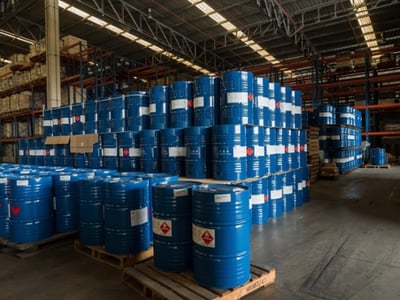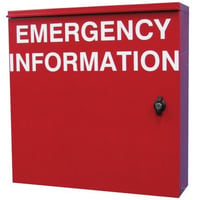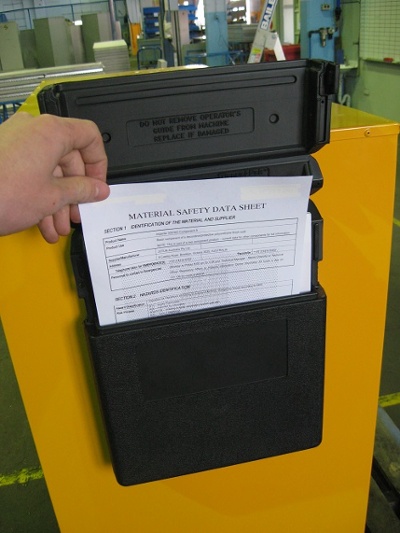When dealing with hazardous chemical records and WHS compliance, you often hear the question, ‘What's the difference between a hazardous chemical manifest and a hazardous chemical register?’ A register of hazardous chemicals and a manifest of hazardous chemicals are two different documents which have different functions (especially in an emergency situation). This post highlights the requirements for a hazardous chemical register and a chemical manifest, explaining what they are, how to determine if you need one or both, and how they should be prepared and stored.
IMPORTANT: You can be fined up to $30,000 for not having the correct hazardous chemical register or chemical manifest. Many workplaces will require both of these documents to maintain compliance.
Hazardous Chemical Register
A register of hazardous chemicals is a list of all the hazardous chemicals held at the workplace, as well as the most recent Safety Data Sheet (SDS) for each of the substances. The register must be easily accessed by workers or anyone likely to be exposed to the hazards presented by the chemicals.
This register can be stored electronically on an intranet database accessible to workers through their individual workstation or via a platform for chemical document management.
However, keep in mind that a hardcopy register kept in a sturdy (liquid-tight) document box is also an acceptable and accessible way of storing your register of hazardous chemicals.
We recommend that you store your register of hazardous chemicals in a document box that’s secured in a highly visible and easily accessible location. Securing your document box near the entrance to your workplace is perhaps one of the best places to locate your important chemical safety documents.
Your register can be kept in hardcopy form, but it’s best to store this document within a liquid-tight document box in an accessible part of your workplace.
The main function of a hazardous chemicals register is to provide essential information about the chemical hazards that are present. This is crucial information that must be available for workers and emergency services when they’re responding to a first aid situation or emergency incident.
Every business that carries hazardous chemicals MUST have a register of hazardous chemicals. This includes any hazardous substances that are stored, handled or used in your workplace.
The information within your hazardous chemical register needs to be kept up to date, so staff are aware of the chemicals onsite - and the appropriate first aid response that is required in the event of an accident.
IMPORTANT: It’s important to make sure you add new chemicals to your hazardous chemicals register. You must also delete any hazardous chemicals that you no longer use at your workplace. Make sure that you include the current SDS (no more than 5 years old) issued by the manufacturer/supplier within your register.
Hazardous Chemical Manifest
A chemical manifest is a detailed document which includes important information about your workplace and the hazardous chemicals that you keep onsite. The purpose of the hazardous chemical manifest is to help emergency service organisations and responders understand the quantity of hazardous chemicals at your site, as well as the hazards that may be present.
Therefore, the hazardous chemical manifest is an integral part of your mandatory Emergency Plan.

The chemical manifest will be required if your hazardous chemicals reach a certain quantity as per WHS law.
You will need to prepare a manifest of hazardous chemicals if the amount of a hazardous chemicals (ie. dangerous goods) at your site is over the manifest threshold quantity. The manifest threshold quantity is specified in the WHS Regulations.
The following information must be included in your hazardous chemical manifest:
- Name of the person conducting the business or undertaking.
- Address of the workplace.
- Date the manifest was prepared (or last amended).
- Contact details of at least 2 people (business hours and after hours numbers) if there is a notifiable incident at the workplace.
- Chemical name (proper shipping name and UN code) and quantity held onsite.
- Hazard Class (including sub-classes of certain chemicals eg, flammable liquids).
- A plan of the workplace drawn to scale with an indicator of true North. The site plan includes things like: entrances/exits; drainage points; the nature of adjoining sites; plus, the location of bulk containers, toxic substances, explosives, and the manifest itself.
One of the most important elements of the manifest is to ensure it is kept up-to-date and that it’s located in a fixed location. This location should be agreed upon with your local emergency services, so that no time is wasted when crews are tending to your work site. Your hazardous chemical manifest must also be shown on your site plan.

The box that you keep your hazardous chemical manifest in should be in a different colour to the box that stores your hazardous chemical register.
We recommend storing your chemical manifest in a sturdy document box that can protect these important documents from dust, rain and vermin. The manifest and emergency information box should be in a distinguishing colour (such as a bright red) and labelled MANIFEST or EMERGENCY INFORMATION. This is so emergency services (and staff) can quickly determine the difference between the hazardous chemical register and the hazardous chemical manifest.
IMPORTANT: The manifest of hazardous chemicals does NOT require copies of the SDS. Therefore, you should not include them when compiling your manifest, as it could slow down emergency services when they are responding to a chemical emergency.
What’s the Difference between a Hazardous Chemical Register and Manifest?
As you can see, there are some key differences between how you should prepare and store your hazardous chemicals register and hazardous chemical manifest. Some important points that differentiate these documents include that the register of hazardous chemicals is mainly for staff to access in their daily operations, while the manifest of hazardous chemicals is for emergency services to use in the event of an incident. Your register can be in either an electronic or hard copy form, but manifest must be in hard copy form at your workplace.
Not every workplace will require a hazardous chemical manifest, so check the WHS laws in your state or territory to see if your business requires a manifest onsite.
Hazardous Chemical Register Vs Chemical Manifest
The following table compares further details that differentiate the hazardous chemicals register from the chemical manifest.
Remember, these two documents are different and are NOT interchangeable.
| REGISTER | MANIFEST | |
| When Required | For all hazardous chemicals kept onsite (except for goods in transit and consumer products) | When quantities of certain hazardous chemicals exceed threshold limits defined in the WHS Regulation. |
| Primary Function | So workers etc can easily find information about chemicals they use at the workplace (eg, first aid responses, safe storage, poisons information, PPE). | So emergency responders know the type of hazardous chemicals (and Dangerous Goods) they could encounter — where they are, their hazard class, and the quantities held onsite. |
| Mandatory Contents | Names of all the Hazardous Chemicals held onsite as well as copies of the Safety Data Sheets for each of the chemicals. | Name of the PCUB; address of the workplace; Date manifest was prepared or last updated; After house contact details for at least 2 people if there is a notifiable incident at the workplace; Chemical names and quantities held onsite; Hazard Classes; scaled plan of the workplace with an indicator of true North. |
| Location | Can be stored electronically or in hard copy — as long as the register is readily accessible to workers (or other people) exposed to the chemicals listed in the register (including emergency service crews). | Must be stored somewhere readily accessible to emergency responders (determined in agreement with the primary emergency service organisation). |
IMPORTANT: The WHS Regulation outlines the exact requirements of the register and manifest of hazardous chemicals including the information to be included, where they should be stored, and the threshold quantities.
Hazardous Chemical Records and Compliance
The hazardous chemical manifest is not to be confused with the hazardous chemicals register, as these are both essential chemical safety documents which can reduce the impact and damage caused by a chemical incident. Having a register and/or a manifest of hazardous chemicals is a requirement of WHS Regulations. However, if your workplace is to fully comply with your legal obligations, you will also need to introduce a risk management methodology into your workplace to identify, assess and control all the chemical hazards. Download our free eBook How To Manage The Risk Of Hazardous Chemicals In The Workplace to learn more about meeting your obligations.
Joining the team as a Dangerous Goods Storage Consultant, Melissa Hampton became Storemasta's Marketing Manager in late 2021. With extensive knowledge and experience in chemical compliance, Melissa is responsible for leading the Marketing team and helping shape their marketing strategy. In her spare time, you can find Melissa hiking, swimming and enjoying the great outdoors in beautiful north-west Tasmania.

